On test: 123-143hp M6002 joins Kubota range
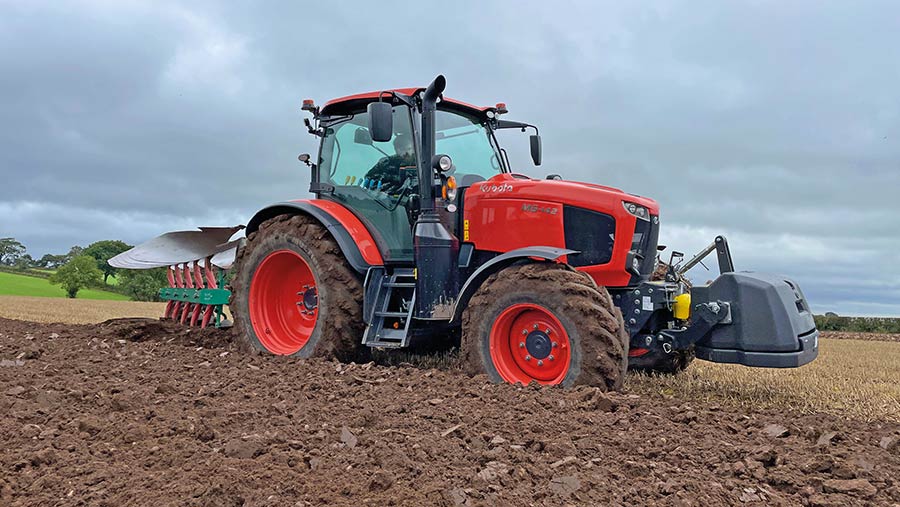 Kubota M6 © James Andrews
Kubota M6 © James Andrews
Short of a tractor range to bridge the gap between its flagship M7003 and utilitarian MGX ranges, Japanese maker Kubota decided it was high time it introduced one.
The M6002 was unveiled in February 2020 and includes three models that run from 123hp to 143hp.
Its aim is to strike a decent balance between yard and fieldwork so that livestock and mixed farms can use it for any job they see fit.
To that end, Kubota’s engineers have given it compact proportions and a tight turning circle, as well as furnishing it with beefed-up running gear, powerful hydraulics and a hefty lift capacity for its size.
Added to that, it can be specced with an Isobus-compatible, in-cab terminal so that operators can run modern equipment without the need to splash out on additional screens.
Rather than sprucing up an existing model, most of the M6’s underpinnings were built from scratch.
This includes a new in-house 24F/24R semi-powershift transmission and a bigger back end than the one used in the MGX.
Another feature that makes it stand out from its utilitarian sibling is a stronger version of the firm’s portal front axle.
This retains the tight-turning Bi-steer function while allowing heavier loads to be carried and both a front linkage and pto to be fitted.
Load-sensing hydraulics also come as standard, rather than an old-school gear pump, plus a higher-spec interior with a joystick controller.
There are more factory-fit loader options to choose from, which are better integrated into the tractor.
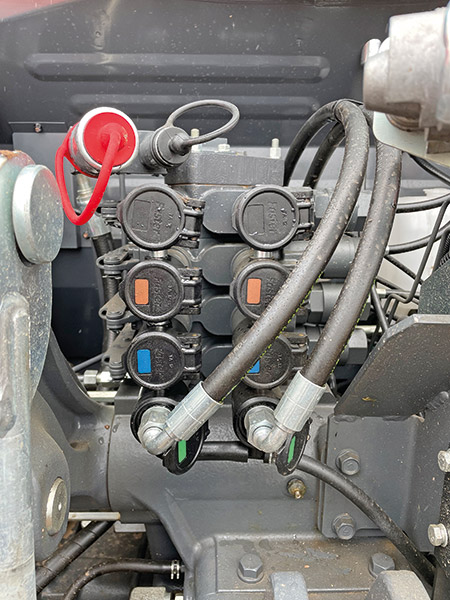
© James Andrews
Keen observers will have noticed that this isn’t the first M6 range from Kubota. However, the model that preceded it was a slightly different beast.
It was essentially a low-spec version of the M7, of which only a couple were sold in the UK, and the only components it shares with the current version are the engine and cab frame.
Launching the M6002 during a global pandemic meant tractors were slow to reach dealerships, but they have been trickling out onto farms for most of 2021.
Unlike the M7s and the former M6, which hail from Dunkirk, the M6002 is built in one the firm’s home factories in Osaka.
The design was penned in France though, and Kubota says it’s been developed specifically for the European market.
To find out how it measures up, we tried out the complete range on a series of tasks, including ploughing and loader work.
See also: 10 scraper tractor options for dairy farms of all sizes
What engine does it have?
All models in the M6 line-up feature the same 6.1-litre, four-cylinder Kubota engine that’s used in the largest MGX and the entirety of the M7 range.
It has a sizeable displacement for a four-pot and, with the top-spec M7 running at 175hp during boost, it shouldn’t be under any stress in the M6.
Thanks to the large bores and a long stroke it also operates at relatively low revs, with max torque delivered at just 1,500rpm.
The result is that it feels surprisingly comfortable on cultivation work.
The range |
|||
|
|
M6-122 |
M6-132 |
M6-142 |
|
Engine |
Kubota 6.1-litre, four-cylinder |
||
|
Max power |
123hp@1,900rpm |
133hp@1,900rpm |
143hp@1,900rpm |
|
Boosted power |
143hp@1,900rpm |
153hp@1,900rpm |
163hp@1,900rpm |
|
Max torque |
549Nm@1,500rpm |
594Nm@1,500rpm |
645Nm@1,500rpm |
|
Transmission |
24F/24R semi-powershift with eight speeds in three ranges (optional creeper gearbox) |
||
|
Top speed |
40kph |
||
|
Rear lift |
7t |
||
|
Front lift |
3.26t |
||
|
Hydraulic pump |
115 litre/min load sensing |
||
|
Spools |
Three (four optional) |
||
|
Max tyre size |
480/65R24 front and 650/60R38 rear |
||
|
Weight |
6t |
||
|
Retail price |
£76,099 |
£79,632 |
£82,454 |
The M6-142 we tried out on ploughing duties had enough torque to rumble along at low revs, even with five furrows in tow; the only caveat being that it was fairly light ground.
Power outputs roughly coincide with the model numbers at 123, 133 and 143hp and, as far as we can tell, all three models are mechanically identical.
This means tuning and spec variations are the only things that set them apart.
Each has a 20hp boost function, but this is only available for transport and kicks in above 20kph.
Two engine speed memory buttons are included on the new joystick controller (more on that later), which are simple to set and use.
The engine meets Tier 5 emissions regs with the help of a diesel particulate filter (DPF), diesel oxidation catalyst (DOC) and selective catalytic reduction (SCR).
In a bid to cut the maintenance burden, the DPF has been given an extended 6,000-hour life before needing a clean and the engine requires servicing every 500 hours.
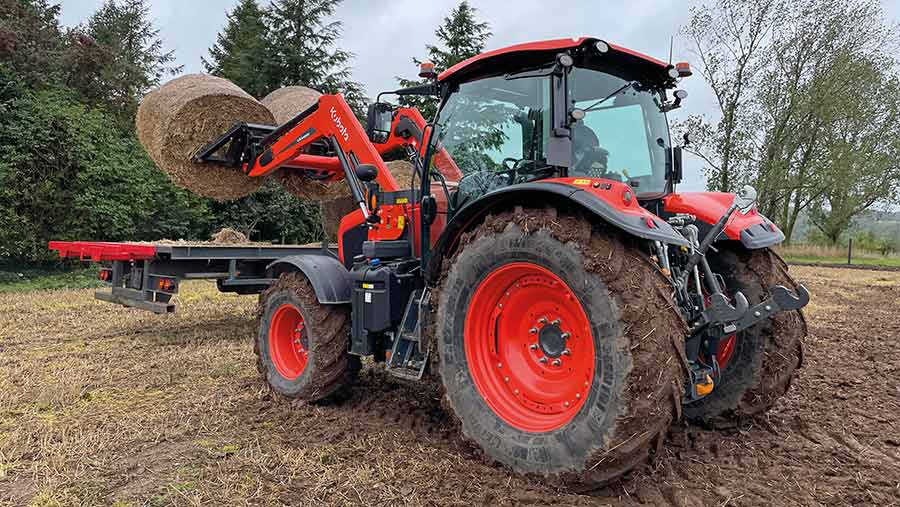
© James Andrews
How many transmissions?
Just one 24F/24R semi-powershift transmission is available in the M6, which has eight powershifts in three ranges, as per the one fitted to the MGX.
An additional creeper box is also available that takes the number of ratios up to 32.
This unit is built by Kubota and has chunkier internals than the MGX version, making it better suited to pulling cultivation kit and towing heavy trailers.
Shifting of the eight powershifts can be set to run automatically, and there’s the option of adjusting the responsiveness of gear changes relative to the load placed on the tractor.
Having eight powershifts on tap means there are plenty of ratios to play with in the field without having to interrupt drive to change range.
To shift manually, the driver just needs to nudge the new joystick forward or backwards, and once the powershifts have been exhausted, a press of a button allows them to keep moving into the next range. When doing so, it’ll automatically speed match the gears.
Buyers that opt to have the 7in K-monitor display get a few more functions to play with, including the ability to set starting gears in each range and the ratio it shifts to when speed matching.
It’s a shame the starting gear option isn’t available for those that can otherwise do without a screen.
Another feature that sets it apart from the MGX is the brake-to-stop function, which means the clutch doesn’t need to be used when coming to a halt.
It’s a handy addition, but it isn’t as refined as some rival systems and lacks sensitivity adjustment.
Top speed is set at 40kph and, to reduce fuel use, the tractor should reach this with the engine running at 1,640rpm.
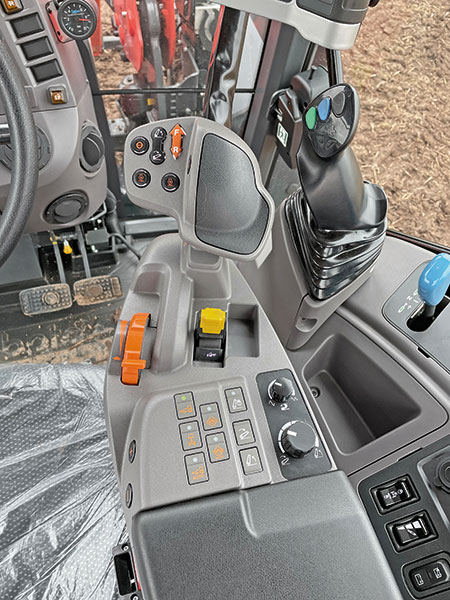
© James Andrews
What’s on the options list?
For the first time in this power category, Kubota can offer buyers a 3.25t front linkage and pto, both of which come from a new tie-up with MX.
The addition of a linkage has been made possible by Kubota’s engineers building a stronger version of its portal front axle with bevel gear drive.
Choosing to do this – rather than using a Dana axle like the M7 – allowed them to retain the Bi-speed steering setup that helps give the tractor a tight turning circle.
This system works by engaging second gear set when the front wheels are turned more than 35deg.
As a result, the front wheels speed up 15% relative to the rears, which hauls the front of the tractor round.
It can’t be engaged on hard surfaces, and it can make a mess on turf, but it’s useful for manoeuvring around wet yards and where a bit of tyre scrub won’t cause too much concern.
Loader options have also increased, with five Kubota-branded MX models on offer, rather than the single in-house option for the MG-X.
The largest model offers a 4m lift height to the pin and a lift capacity of up to 2,400kg.
Is there a new cab?
Kubota hasn’t built a new cab frame for the M6002, but it does have some modified internals that make it stand out from its siblings.
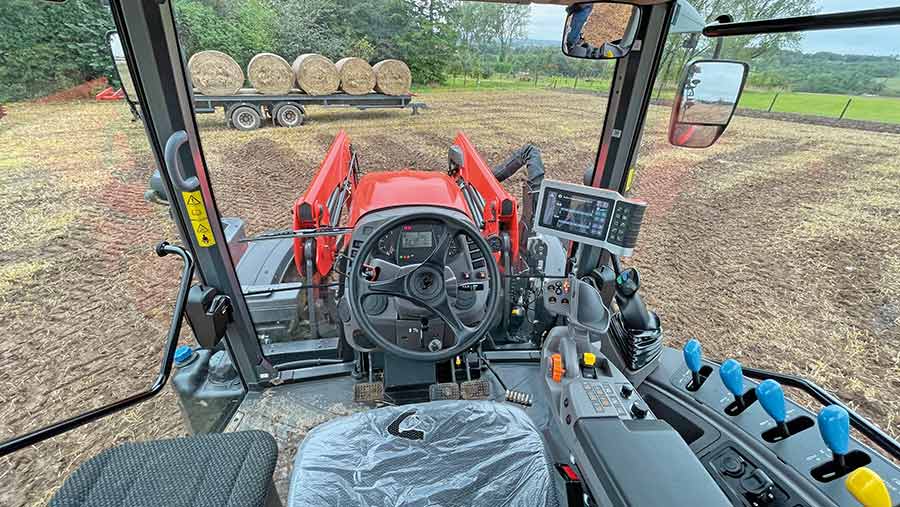
© James Andrews
These include a different dash surround and seat-mounted armrest that’s home to the M6’s own palm-shaped joystick controller.
This is standard fitment on all models and its functions include gear shifting and operating the rear linkage, plus accommodating an engine rev memory function and a forward reverse shuttle.
It’s handy to use and the only element that’s a bit clunky is the shuttle, which requires a second button to be depressed behind the joystick before it will activate.
The main left-hand shuttle lever is more user-friendly, with a comfortable shape and clear neutral position – it is just missing a park position.
As a result, the handbrake must be used and, as this protrudes into the footwell, it is easily smeared with mud.
Opting for the K-monitor screen brings in more transmission setup options (as mentioned earlier), as well as the ability to run Isobus implements, section control and variable-rate applications.
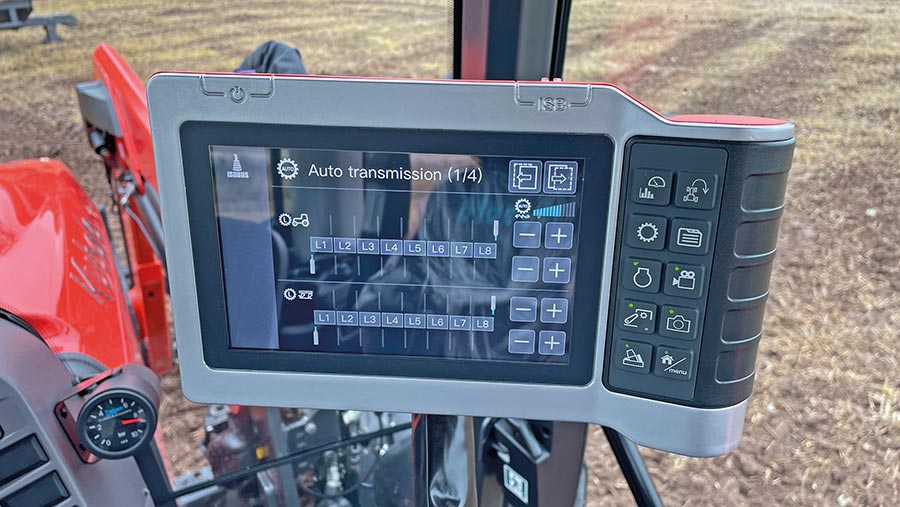
© James Andrews
The rest of the cabin is simple and fuss-free, with manual spool levers and a moderate selection of buttons to set the main functions.
Quality of the materials and the level of finish would be a tad poor in a higher-horsepower tractor, but they’re adequate for a tractor of this calibre.
M6s don’t come auto-steer ready, but Kubota does offer a steering-wheel mounted system for those that want one.
How much can it lift?
Lift capacity across the M6 range is a healthy 7t at the rear and the optional MX front linkage is rated to carry 3.26t.
Rear linkage control is put in the hands of buttons on the joystick and depth control is handled by a small knob on the armrest.
This isn’t that handy to hold for jobs such as ploughing, where regular adjustments are required, and it lacks a physical depth stop. However, it’s fine for most other duties.
The M6’s implement-lugging abilities are backed up with a slicker hydraulic system than the firm uses on the MGX range.
This has a 115-litre/min load-sensing pump, in place of a gear pump, that feeds up to four manual spool values.
Four pto speeds come as standard – 540, 540e, 1,000 and 1,000e – which is generous for a tractor in this class.
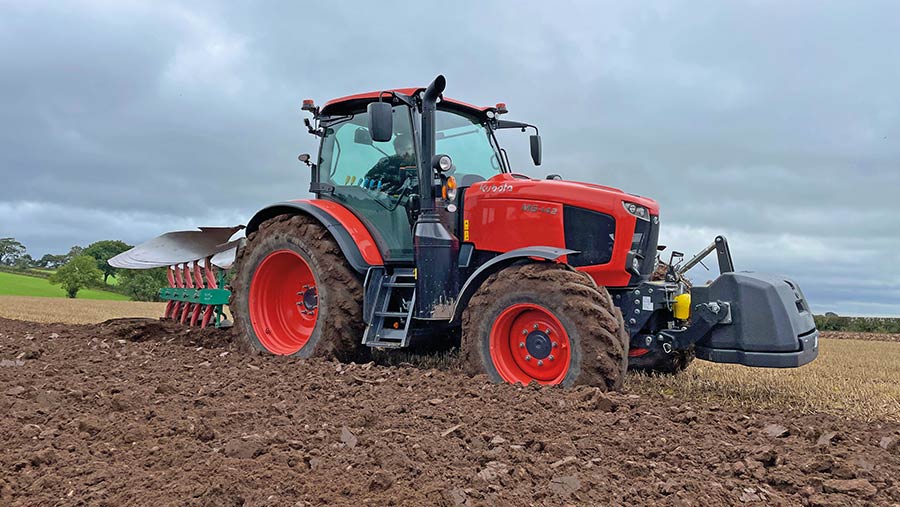
© James Andrews
Is it any good?
Low-spec loader tractors have long been Kubota’s forte, but the arrival of the M7 in 2015 showed that the firm could offer higher horsepower and decent levels of tech that rival the big guns.
The M6 occupies the middle ground, retaining those all-important yard tractor qualities – tight turning circle, simple controls and compact proportions – while introducing some arable-grade features that mean it can hold its own in the field.
Compared with some four-cylinder rivals, the big-bored engine feels like it’s well on top of the job, it’s got impressive lift capacity for its size and load-sensing hydraulics are a welcome upgrade.
Buyers will also appreciate the larger range of factory-fit loaders on offer and the fact they can have a front linkage and pto.
Some of the new features – such as the brake-to-stop function – lack the polish of those offered by rivals but, all things considered, it seems to be a solid contender.
Retail prices for a base-spec M6-122 start at £76,099 and go up to £82,454.
Likes and gripes
Likes
- Gutsy engine
- Tight turning circle
- Eight powershifts in each range
- Seat-mounted controls
Gripes
- Optional screen required to set starting gears
- Jerky brake-to-stop function
- Clumsy right-hand shuttle
- Boost for transport only

